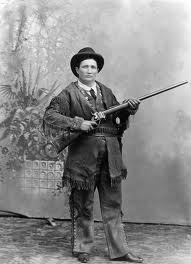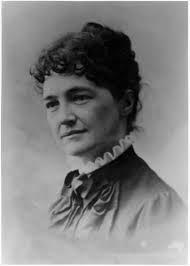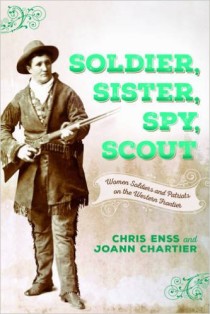1851 – San Francisco’s fifth fire since the discovery of gold destroys 70 percent of the city.
Clare Hodges – A Ranger in Yosemite
Celebrate the 126th anniversary of Yosemite!
Enter now for a chance to win the book
High Country Women: Pioneers of Yosemite National Park
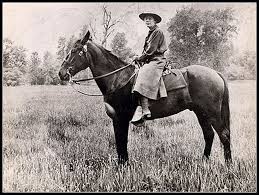
Twenty-seven-year-old Clare Hodges gently urged her chestnut roan through a thicket of trees and brush. The horse’s hooves barely made a sound as it walked over a thick carpet of pine needles and maple leaves. Bright streams of sunlight filtered through the branches of sequoias and spilled onto the ground with brilliant intensity. A light breeze escorted rider and her ride out of the forest and deposited them at the edge of a massive emerald meadow. Jagged lofty peaks waited on the other side of the grassy area, and above it all was a cloudless, deep blue sky, verging on the color of Indigo.1
Clare surveyed Yosemite’s Kings River Canyon carefully. A park ranger for all of two months, patrolling the spectacular setting was part of her job since signing on with the National Park Service in late spring 1918. An article in the June 1, 1919, edition of the Lima, Ohio, newspaper The Lima News, reported that Clare’s love for the mountains prompted her to pursue a profession as a park ranger and that “the beauty of the region made the work a pleasure.”2
One of the many duties Clare had as a park ranger was to routinely scrutinize the bold peak of Mount Hutchings (a 10,758 foot peak overlooking Kings River Canyon) for rock climbers in trouble and the floor below the summit for hikers who had lost their way. She never encountered anyone in such a dire predicament. As she studied the vast area “the spray from the fifty foot waterfall over the steep mountain would fall on my face,” Clare recalled later in her life. “The water made a beautiful fan of foam that spread out in a turbulent, eddying mass into the roaring river below.” Apart from the herds of mule deer, eagles, a few cougars, curious chipmunks, and wolves, Clare rarely encountered any living inhabitants in her daily routine. “My life as a ranger is not as wild and woolly as it sounds,” she told The Lima News.3
To learn more about Clare Hodges and the women who helped make
Yosemite a National Park read
High Country Women: Pioneers of Yosemite National Park
Entertaining Women at the Autry Museum of the American West
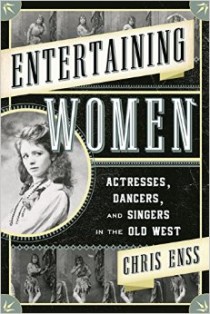
You’re cordially invited to attend the Cowboy Lunch Series at the Autry Museum of the American West in Los Angeles on May 18, 2016 for a special tribute to actor/director John Wayne.
The Cowboy Lunch Series brings together western filmmakers and stars with Autry Museum members and other fans of the genre. Order lunch at Autry’s Crossroads Café and join actors, producers, stunt coordinators, makeup artists, writers, and other surprise guests. Hollywood producer, Rob Word hosts “A Word on Westerns” a group discussion based on the particular theme or film of the month.
The theme for the May Cowboy Lunch Series is a Salute to Wayne. John Wayne’s son actor Patrick Wayne will be in attendance to discuss his father’s work. New York Times Bestselling author Chris Enss will also be on hand to talk about her book Entertaining Women: Actresses, Singers, and Dancers of the Old West. She’ll share stories about women entertainers on the wild frontier and how they inspired some of the actresses who starred opposite John Wayne.
The event is free to the public. Cost of lunch is not included.
For more information visit http://theautry.org or call 323.667.2000.
This Day…
High Country Women: Pioneers of Yosemite National Park
Celebrate the 126th anniversary of Yosemite!
Enter now for a chance to win the book
High Country Women: Pioneers of Yosemite National Park
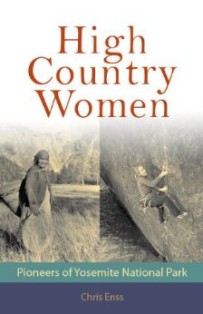
The United States was preoccupied with a Civil War when Congress approved the measure signed by President Abraham Lincoln that made Yosemite a National Park. In spite of the terrible strife the country was experiencing politicians and conservationists believed action needed to be taken to preserve the wilderness nestled in the Sierra Nevada Mountains.1
The seven-hundred and sixty-one thousand acres that featured giant sequoia groves with trees thousands of years old and many unique geological formations was the destination of choice for many fur trappers and adventurers. In the mid-1820s beaver, bear, and mountain lion hides were in great demand, and expanding the western boundaries beyond the Mississippi river was encouraged by entrepreneurs and officeholders. Fearful that Yosemite’s natural beauty would be eroded away by the progress of civilization, concerned individuals pressed lawmakers to make the area off limits to Argonauts, hunters, and land developers. On June 30, 1864, Yosemite became the first scenic reservation by a central government.2
Frontiersman Joseph Reddeford Walker is credited with discovering Yosemite Valley in 1833 when he led an expedition of fifty men into the mountainous California territory. By 1849 a sea of humanity was migrating west. Driven by the Gold Rush and a desire to settle in a new land, prospectors, farmers, businessmen, ranchers, innkeepers, cooks, laundresses, teachers, and entertainers hurried to the West Coast. Men and women miners and their families pushed their way passed the Native Americans living in the Yosemite Valley with the intention of stripping the region of its gold. Indians who resisted the incursion of small gold mining operations on the Merced River were moved to a reservation near Fresno.3
White men such as naturalist John Muir and women such as author and political activist Jessie Fremont opposed the idea of mining in the scenic locale. Both believed the natural beauty of the area and wildlife would be threatened if exposed to toxic chemicals used to separate gold ore from rock. John spent years studying Yosemite Valley’s geology and botany and had determined its mountain ranges were formed by glacial erosion. The Maidu, Miwok, and Paiute Indians disagreed with his research. Indian legend passed down from father to son and mother to daughter insists that the mountain Half Dome, her husband, Washington Tower, and their infant son did it all.4
As the story goes, Half Dome lived with her husband, Washington Tower on the bank of the Merced River at a point on the edge of the San Joaquin Valley. Owing to some quarrel with her husband, Half Dome ran away toward the east. As she proceeded up through the mountains she created the upper course of the Merced River and the Yosemite Valley itself. She carried a burden basket, a finely feathered basket and her baby in its cradle. In the finely feathered basket she carried a smaller basket containing seeds of various kinds which she planted all along the way. Hence, there are many different kinds of these trees and foods now.5
Finding that his wife had left him, Washington Tower cut a white oak club and started after her. He overtook her near the point where this great peak now stands. She had taken her baby out of its cradle basket and placed it on the top of the load in the burden basket, carrying the cradle meanwhile under her arm.
Washington Tower whipped Half Dome severely. The burden basket was broken and fell with its contents into Mirror Lake. It has never since been seen. The basket containing the seeds was thrown to the north side of the canyon. It landed bottom up and became North Dome.
Half Dome threw the baby cradle against the north wall of the canyon where it now appears in the Royal Arches.
As Half Dome received her punishment she wept bitterly and was transformed into the great peak. The dark colored streaks on the vertical wall on the north of Half Dome are the tear stains on her face. She wore, at the time, a buckskin dress but nothing now remains to indicate it.
The club Washington Tower used was finally thrown aside. It landed upright in the center of Mirror Lake and remained there for some time as a large, black snag. When Washington Tower had spent his wrath he went over to the north side of the valley where he has since remained a great shaft of granite.6
Maria Lebrado, a member of the original Yosemite Indian tribe, shared this tale about the origin of the region with the pioneers who moved into the valley, the majority of which were men. Only ten percent of the white population that invaded Yosemite in the early 1850s were women. Though their numbers were few, the impact they had on the areas was as lasting as the exploits of Half Dome. For example, Elvira Hutchings came to Yosemite with her husband in 1855 and began her career as one of the original innkeepers in the valley. She was more than twenty years younger than her husband, James Mason Hutchings, the man who led the first tour party into Yosemite. Their marriage didn’t last but the inn she helped establish did.7
Ida Tinsley Howard was the valley’s first schoolmarm in 1876. She came west with her father who operated a resort on Mirror Lake at the east end of Yosemite. Ida made sure her students were proficient in math, especially algebra.8
Carefree maid and waitress Kitty Tatch was a pioneer in the field of photography in Yosemite, in front of the camera, however, not behind. She was unafraid of heights and posed precariously on ledges and cliffs around the park. Pictures of her were sold as postcards to visitor at valley restaurants and stage stops.9
In 1905, Agnes Wikenson, Ann Taurer, Ethel and Ann Fullerton were the first women in Yosemite to be held up by a highwayman. The stagecoach the ladies were traveling in was stopped by an armed, masked bandit who took all the money the women had. The stage passengers continued on to their destination, a campsite near Indian Village, and were in the valley when the fugitive was arrested by authorities in Sacramento two days after the incident.10
To learn more about the women who helped make
Yosemite a National Park read
High Country Women: Pioneers of Yosemite National Park
This Day…
Elizabeth Custer – Champion of the Seventh
The difference between winning and losing is most often…not quitting.
Enter for a chance to win a copy of the new book
Soldier, Sister, Scout, Spy:
Women Soldiers and Patriots of the Western Frontier.
It was almost two in the morning, and Elizabeth Custer, the young wife of the famed “boy general” George, couldn’t sleep. The heat kept her awake—a sweltering intense heat that had overtaken Fort Lincoln in the Dakota Territory earlier that day. Even if the conditions had been more congenial, however, sleep would have eluded Elizabeth. The rumor that had swept through the army post around lunchtime disturbed her greatly, and, until this rumor was confirmed, she doubted that she’d be able to get a moment’s rest.
Elizabeth, or Libbie as her husband and friends called her, carried her petite, slender frame over to the window and gazed out at the night sky. It had been more than two weeks since she had said good-bye to her husband. She left him and his battalion a few miles outside the fort. George had orders from his superior officers in Washington, DC, to “round up the hostile Indians in the territory and bring about stability in the hills of Montana.” Elizabeth knew he would do everything in his power to fulfill his duty.
George and Elizabeth said their good-byes, and she headed back to the fort. As she rode away, she turned around for one last glance at General Custer’s column departing in the opposite direction. It was a splendid picture. The flags and pennons were flying, the men were waving, and even the horses seemed to be arching themselves to show how fine and fit they were. George rode to the top of the promontory and turned around, stood up in his stirrups, and waved his hat. They all started forward again and in a few seconds disappeared—horses, flags, men, and ammunition all on their way to the Little Bighorn River. That was the last time Elizabeth saw her husband alive.
Over and over again, she played out the events of the hot day that had made her restless. She and several other wives had been sitting on the porch of her quarters singing, reluctant for some inexplicable reason to go inside. All at once they noticed a group of soldiers congregating and talking excitedly. One of the Native scouts, a man named Horn Toad, ran to them and announced, “Custer killed. Whole command killed.” The women stared at Horn Toad in stunned silence. Finally, one of the wives asked the man how he knew that Custer was killed. He replied, “Speckled Cock, Indian scout, just come. Rode pony many miles. Pony tired. Indian tired. Say Custer shot himself at end. Say all dead.”
Elizabeth remembered George’s warning about trusting in rumors. She believed that there might have been a skirmish but felt it unlikely that an entire command could be wiped out. At that moment, she refused to believe George would ever dare die. She would wait for confirmation before she did anything else. Now, in her bedroom, listening to the chirping of the crickets and the howls of the coyotes, she sat up, wide awake, waiting.
The loud sound of boots tromping across the path toward her front door gave her a start. She hurried to the door and threw it open. Captain William S. McCaskey entered her home, holding his hat in his hands. He didn’t want to be there. Elizabeth looked at him with eyes pleading. “None wounded, none missing, all dead,” he sadly reported. Elizabeth stood frozen for a moment, unable to move, the color drained from her face.
“I’m sorry, Mrs. Custer,” the captain sighed. “Do you need to sit down?”
Elizabeth blinked away the tears. “No,” she replied. “What about the other wives?”
“We’ll let them know of their husbands’ fates,” he assured her.
Despite the intense heat, Elizabeth was now shivering. She picked up a nearby wrap and draped it around her shoulders. Her hands were shaking. “I’m coming with you,” she said, choking back the tears. “As the wife of the post commander it’s my duty to go along with you when you tell the other . . . widows.” The captain didn’t argue with the bereaved woman. He knew there would be no point. Elizabeth Custer was as stubborn as her general husband—if not more so.
To learn more about Elizabeth Custer
and the lives of many other courageous women read
Soldier, Sister, Scout, Spy:
Women Patriots and Soldiers on the Western Frontier.
Posse Makes Way to Nebraska, History Riding With Them
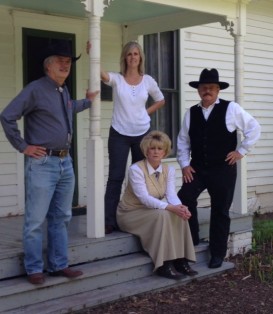
Take a literary ride with the Most Intrepid Western Author’s Posse as they travel through the sand hills and Great Plains of Nebraska. The Most Intrepid Western Author’s Posse is comprised of five published, award-winning western authors; Monty McCord author of Mundy’s Law: The Legend of Joe Mundy and Hastings: The Queen of the Plains; Sherry Monahan author of Mrs. Earp: The Wives and Lovers of the Earp Brothers, The Cowboy Cookbook, and Frontier Fare; Bill Markley author of Deadwood Dead Men and Dakota Epic: Experiences of a Reenactor During the Filming of Dances with Wolves, Kellen Cutsforth author of Buffalo Bill, Boozers, Brothels, and Bare-Knuckle Brawlers: An Englishman’s Journal of Adventure in America, and Chris Enss author of Frontier Teachers: Stories of Heroic Women of the Old West, Hearts West: Mail Order Brides of the Old West, and Object Matrimony: The Risky Business of Mail-Order Matchmaking on the Western Frontier will tell exciting tales of the Old West.
Stories told by the posse promise to transport readers back to the days of the wild frontier when times were rowdy and justice was swift.
The Most Intrepid Western Author’s Posse’s first stop will be in Beatrice at the Homestead National Monument of America on Saturday, June 11 from 2 p.m. – 4 p.m. On Sunday, June 12 the Posse will be at the Stuhr Museum in Grand Island from 3 p.m. – 5 p.m. The Posse will be discussing their books and the legendary characters that helped shape the American West.
For more information visit www.chrisenss.com.
This Day…
Soldier, Sister, Spy, Scout
Winning isn‘t everything, but wanting to win is.
Enter to win a copy of the new book
Soldier, Sister, Scout, Spy:
Women Soldiers and Patriots of the Western Frontier.
From the earliest days of storytelling, the courageous man has been celebrated in myth and legend. Every culture develops stories about dauntless adventurers, valiant patriots, fearless warriors, and heroic leaders. These stories teach as well as entertain and set up positive role models to inspire future generations. Sometimes, these dauntless, valiant, fearless, and heroic individuals are women.
The true stories you’ll find in this book about women in the American West illustrate the depth of courage, the physical bravery, and the commitment to a cause that impelled them to throw off the constraints of nineteenth-century conventions and plunge into situations that many men of their era would not, and did not, face.
In the latter half of the nineteenth century, the US Army battled western Native American tribes over territorial rights, resources, and culture. Each side had its motives, its victories, its defeats, its victims, and its heroes. Among those heroes, on both sides, were women—wives, mothers, interpreters, laundresses, soldiers, and shamans—who willingly headed into the unknown, into a land fraught with danger and hardship. Courageous defines the character of the thousands of women who left the towns and cities of the East for the unknown dangers of the western territories. Setting up housekeeping in wild, unsettled lands, risking their lives on the journey, and bearing children under primitive conditions tested their courage daily. The stories selected for this book describe some who went two or three steps beyond the ordinary, everyday courage of women in the West.
To learn more about these courageous women read
Soldier, Sister, Scout, Spy:
Women Patriots and Soldiers on the Western Frontier.

